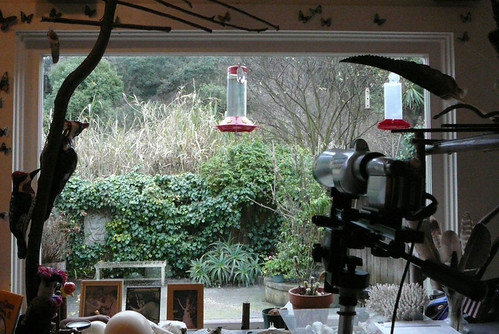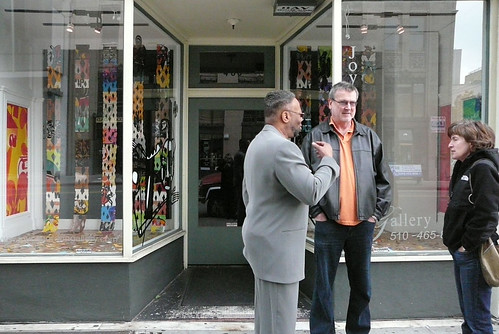

Last week I attended a thoughtful lecture by Tim Brown, CEO of
IDEO, a global design consultancy. He was at
California College of the Arts to talk about his new
book,
Change by Design: How Design Thinking Transforms Organizations and Inspires Innovation.
Brown's own company is a model of transformation and innovation. A quote from the lecture announcement indicates how wide-ranging its scope is: "IDEO's mission is to fuse design, business, and social studies to come up with deeply researched, deeply understood designs and ideas. IDEO works on projects in a variety of industries, including computers, furniture, medical, sporting goods, telecommunications, toys, and transportation. It has designed and prototyped a life-saving portable defibrillator, the defining details at the groundbreaking Prada shop in Manhattan, Apple's first mouse . . . and Microsoft's second mouse."
The audience spilled out of CCA's Timken Lecture Hall and into an adjacent area. That's where a lot of us were, watching on a large screen. While he's very passionate about his ideas, Brown seems affable, as well as very modest about his own accomplishments. Although he has extensive training and experience as an industrial designer, he has a far more wide-ranging view of how "design thinking" can be applied. According to Brown, "design thinking is an approach that uses the designer's sensibility and methods for problem solving to meet people's needs in a technologically feasible and commercially viable way. In other words, design thinking is human-centered innovation."
Brown advocates using design thinking to make a difference in all areas of life, not just in those traditionally thought of as design targets. Design thinking can impact the way people design everything from a computer mouse or a building to economic models and healthcare. He makes the case that society itself would work much better if everyone--not just professional designers--approached problems with a childlike curiosity and a willingness to experiment. "The key to education," says Brown, "is to not eradicate kids' natural inclinations. Most people had their last good design education in kindergarten." Kindergarten is usually the last time in their schooling where children are allowed the freedom to examine problems in depth, collaborate, and then design unlimited prototypes. [Although this too has changed; given the pressure to push academics earlier and earlier, kindergarten has become the new first grade.] Children naturally experiment extensively and work together when they are given the opportunity for free play; this is the way they learn how the world works and how to solve elemental problems in natural, creative ways.
Collaboration is also valued at IDEO, whose staff is composed of professional designers and non-designers alike. All are encouraged to practice design thinking: to think deeply about a problem, ask a lot of questions, work together, make prototypes, and not fear failure. In fact, Brown encourages people to "fail early, and fail often." It's better to test a design on 5 or 10 people first, and fail--even repeatedly--than to inflict the design on thousands of people and THEN find out it doesn't work well. "Designers often impose changes on people's lives and forget how painful change can be." If some system in a workplace, for example, isn't designed well, people may be extremely unhappy; perhaps they even quit, and no one may even realize why.
That's a main reason why it's so important to start with a person's comfort zone when introducing a change in behavior. IDEO focuses on studying people's existing situations and behaviors, and then builds on what's working right. Bank of America approached IDEO several years back with a problem: many people were not using the bank as a place to save money. Why not? Didn't they see the importance of saving? IDEO studied people's habits and found that--while people weren't necessarily using traditional savings accounts--they were consistently saving money in other, small ways. IDEO identified two widespread behaviors:
1) People tend to round up their utility bills. If the electricity bill is $47.68, for example, they might pay $50.00. When asked why they do this, they explain that they just want to make sure they never forget the bill and always have enough to pay it.
2) When people receive change from a cash transaction, they tend to save the change in, for example, a jar at home. They keep adding to it until it reaches a significant amount, and then spend it only if they need to.
In other words, people do want to save, and they will do it if it is built into their natural activities. IDEO took advantage of this impulse and invented BofA's very successful "keep the change" program: a painless way to save small amounts of money, with the added incentive of the bank matching the savings up to a certain amount. By studying the problem carefully and finding out what people were already doing naturally, IDEO was able to find a "win-win" answer to the problem of saving money.
But Brown also cited several examples (mentioned in the book) showing the importance of implementing design thinking to solve some of our toughest problems, such as how to fight diseases, how to improve education, or how to design water distribution in a developing country. Too often we have thought that big problems like this can best be solved by, as Brown says, "getting a few bright folks in California to think of solutions." However, research consistently shows that participatory social contracts work best: foundations and/or governments enabling NGOs and the people themselves to actually design and deliver the product in ways that work best for
them.
Lastly, Brown urged everyone to think of life itself as a prototype. We have the opportunity to design our lives. "We have built societies where we don't reflect; we rush through our lives, either not thinking about them, or going to the other extreme and overplanning them. Don't be completely aimless," Brown urged, "but don't be so preplanned that you don't see opportunities and take them. Step back and observe yourself and others. You may find that there are better ways to interact and to do things." We can use design thinking to help in everything from small things--like designing gatherings to be more enjoyable to ourselves and others--to making big decisions more successfully.
IDEO's website has a
Change by Design page, which includes a definition and a diagram of how design thinking works.
CCA has an
events page with a lot of useful links to upcoming exhibitions, lectures, and workshops.
Tim Brown also has given a
TED talk, which I found interesting and fun.
--Ramona Soto (bluemonk)






 Last week I attended a thoughtful lecture by Tim Brown, CEO of
Last week I attended a thoughtful lecture by Tim Brown, CEO of 











